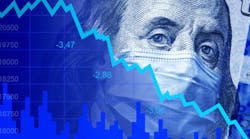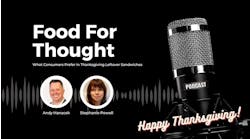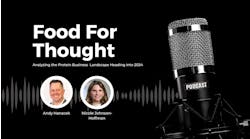In this episode of the Food For Thought Podcast, Food Processing's Dave Fusaro and Pan Demetrakakes talk to podcast host Erin Hallstrom about the findings in our Top 100© list for 2021.
Throughout the episode, we talk about how the pandemic impacted many food and beverage processors' bottom lines. We cover issues like labor and lawsuits while wrapping up the episode with our predictions for the rest of 2021.
Transcript
Erin: Dave, Pan, great to have you back on the Food For Thought Podcast again. Dave, I really want to get started talking about the Top 100. What is it and where are the numbers generated from?
Top 100© Food and Beverage Companies for 2021
Food Processing's 46th annual Top 100© list ranks food and beverage processors based on their sales of value-added, consumer-ready goods that were processed in U.S. and Canadian facilities. Sign up to receive your very own copy of the 2021 Top 100© listings in both PDF and Excel formats. Get Your Copy Here
Dave: We've been doing the Top 100 for many years, it even precedes me on Food Processing, and I've been here almost 20. The companies, they may seem simple and similar, but the US and Canadian Food and Beverage companies are a complicated lot.
When I took over Food Processing Top 100© nearly two decades ago, I wanted to create a list of representative companies as US and Canadian manufacturers of consumer-ready, not necessarily branded, but food products. And that may seem overly obvious but at the time, Anheuser Busch had amusement parks and golf courses and an aluminum can business. PepsiCo manufactures almost as much product overseas as it does here. And Cargill owns ships and trains and iron ore mines all over the globe.
I don't think any of those things should be included in the sales figure that tries to represent these companies as North American food or beverage processors. There are some other lists out there in the media business, but they include all those things as well as the leading aloe jelly shot company in China, which I think is entirely irrelevant to a North American audience.
So that's why these numbers are unique. Not all of them are impossible to find. Tyson and PepsiCo for example, clearly indicate how much in sales comes from their overseas plants. And the US and Canada are huge markets for Unilever, so big that they normally break those sales out in their annual report. And it's easy for me to find. Weston clearly separates the gross sales of its chain of Canadian grocery stores from the product that it makes for those stores.
But it's not easy with companies like Cargill and J. R. Simplot, even Purdue, our 2020 Processor of the Year has a lot more than chicken going on, with operations in grains and energy and recycling.
All three of those companies are private companies too, so coming up with their figures, both because they're private and because they have a lot of side businesses, is a big challenge.
Erin: What are some of the top line things that you saw in creating the 2021 Top 100 list?
Dave: Well, when I started this year's project, I kind of expected the collective sales for big crude, the 100 companies represented in this report. Expected that to be up maybe double digits. I knew there were losers, companies with manufacturing plants that were shut down by the pandemic or who were too reliant on food service. But generally, I expected a healthy increase for the collective group.
But when I totaled up the entire sales column for 2020, sales for the entire 100 companies increased just 1.7% last year over 2019. Now 1.7% on a base of more than $500 billion is nothing to sneeze at. Still, I kind of expected more.
I think that 1.7% growth sounds all the more anemic when you factor in that some companies have exceptionally good years. For example, the US and Canadian operations of Grupo Bimbo, and that'd be Bimbo Bakeries USA and Canada Bread, saw sales rise more than $1.2 billion in 2020 at 16% to $8.8 billion. And again, just US and Canada.
Mondelez added a billion dollars, up 15%. PepsiCo was up $2 billion, an increase of 5%. Other double-digit sales increases included Grupo Lala’s US operations, +22%. B&G Foods up nearly 19% and Unilever's US food business +18%.
In a year that was difficult for big brewers, Boston Beer Co. the maker of Samuel Adams beer, but more importantly, a host of trendier alcoholic drinks was up a whopping 39%. Also remarkable were some of the profit increases. Conagra's net was up 54% for the year. Bimbo SA rose by a third. And Campbell's was up nearly eight-fold. TreeHouse Foods, which is still kind of in the midst of a portfolio reshaping, went from a $360 million loss in 2019 to a $14 million profit in 2020.
Also remarkable, and this was true when we created this year's report, but as of this week is no longer true, not one company from the 2019 Top 100 disappeared off the list due to acquisition. That's the first time in my memory that's happened. As I said, as of this recording, with the acquisition of Sanderson Farms by Cargill and Continental Grain, although I think that will result in the removal of Wayne Farms, not Sanderson, from our 2022 report, as that smaller poultry company will be merged into a suddenly private Sanderson Farms.
Erin: Pan, What were some of the companies that did poorly during the pandemic? And can you elaborate on why?
Pan: I'm going to take the 'why' part of that question first. Whether you did well or not during the pandemic depended overwhelmingly on a single factor: How much of your business was in retail versus food service.
As is a familiar story by now. People couldn't go to restaurants during the pandemic and that caused a huge and sudden drop in food service demand. Companies that depended heavily on food service for their sales found themselves flat footed.
I think that probably the most outstanding example of this is there's two great rivals, PepsiCo and Coca-Cola. PepsiCo is in a fortunate position because it was straddling the fence so to speak. It has a big presence in food service, especially hospitality, fountain drinks, entertainment venues, fast food restaurants, just food service in general. But it was fortunate enough also to have a big presence in retail with Frito-Lay. And Frito-Lay makes comfort food, which was in great demand during the pandemic, as we all know. What's more comforting than big old handful of potato chips? And so that was why PepsiCo went up 5% in sales.
Coca-Cola, which makes similar products, beverage products, of course, has a much more exposed position because more of its sales are in food service, and that's why they went down 4% in sales.
Now for the meat sector, which was arguably the most disrupted in the pandemic, results were mixed. Tyson and Smithfield had sales that were up slightly, but JBS's net income was cut nearly in half. Its sister company, poultry processors Pilgrim's Pride, its income was cut fivefold. The income of Sanderson Farms was halved, which may explain why it was just recently sold.
Now, meatpackers had a unique set of challenges. They had to deal with a food service to retail shift like most food processors, and they also had a very bad situation with COVID outbreaks in their plants. They struggled with that, plants were closed, there was a great deal of acrimony about what can or should be done to protect workers. And that's why it all served as a very tough situation that they found themselves in. And some of them also had problems unrelated to the pandemic, like trying to work their way out of price fixing lawsuits relating to their conduct for the last 10 years or so.
Now, there are some companies that did relatively well, like General Mills and Boston Beer, as Dave said, but they were hit with higher costs for contract manufacturing and extra pay and bonuses for workers. Now, some fortunate companies saw a drop in business due to the pandemic, but it was mitigated by good business practices and other aspects of their operations.
For instance, AB InBev lost 10% in sales worldwide because a lot of beer is consumed at bars and taverns that people could no longer go to. But AB InBev's North American business sales were up almost 1% due in large part to introduction of new products, principally Bud Light Seltzer and Budweiser Zero, both of which tapped into the trend, the consumer trend for lighter alcohol or no alcohol beverages.
Erin: Dave, back to you with a question. In addition to the human toll, did the pandemic create some unique costs for food and beverage companies?
Dave: it certainly did. The human toll and the unquantified or subjective business toll, I think we chronicled all through 2020. But it's interesting to see some of the public companies specify, sometimes even quantify, pandemic costs in their annual reports.
Boston Beer noted it experienced higher labor and safety related costs at the company's breweries, and it noted COVID-19 related safety measures resulted in a reduction of brewery productivity. So much so they had to shift some volume to third party breweries, which increased production costs and negatively impacted gross margins for them. But it did wonders for the contract manufacturers they use, of course. We did a cover story back in May about contract manufacturers and how the pandemic suddenly meant more work for them.
Apparently, Mondelez couldn't make enough Oreos to comfort us in this time, so they had to contract even more of that manufacturer than they already had.
Nestlé S.A. actually quantified the cost of the pandemic in their report. 2020 COVID-19 related costs were 420 million Swiss francs, and that's about $475 million US dollars. And they said that included expenses for bonuses paid to frontline workers, employee safety protocols, donations, and other staff and customer allowances. The company also absorbed an estimated cost of about $192 million US related to staff and facilities made idle due to lockdown measures. Although it admitted there were some savings in travel expenses.
Erin: Pan, Can you talk about how much growth shareholders can expect coming out of the pandemic and how well the biggest food companies managed these expectations?
Pan: Well, shareholders are shareholders, they always want all the value, all the money that they can get. So the way that this will probably play out as we come out of the pandemic is that if a company has heavy presence in food service and hospitality and lost a lot of business due to that, the shareholders are going to expect them to get those dollars back as soon as possible.
If the company was heavy in retailing, and they enjoyed a nice sales bump because of consumers sheltering in place and cooking at home, the shareholders are going to want to keep those gains as much as possible.
Now, one thing I've noticed is that companies that are heavy in retail like Kraft, Heinz are already in a way managing expectations because in their quarterly reports, they're including comparisons not just to the same quarter in 2020, but to the same quarter in 2019. Because comparing the current quarter results to what they were experiencing during the pandemic month is going to be a net negative, and so they're more or less explicitly telling their shareholders, "Look at what we were doing before the pandemic hit."
[sidebar id=1]
Now, I suspect that companies that are heavy in food service are going to do the exact opposite. They're going to look at how much better they're doing now than they were at the height of the pandemic, and pro about it. This is called spinning. It's what companies do.
Now, I feel that the best companies, the ones that are really on top things, are going to have plans in place for consolidating, keeping and improving on the gains to be made during the pandemic, such as keeping people cooking at home, capitalizing on that new enthusiasm with new products, new promotions, etc.
Or conversely, if they had losses during the pandemic because they were heavily into food service, the best ones are going to try to capitalize on the excitement that consumers are feeling at being able to go out and have a good time again with new products, extra marketing, and, you know, whatever they can do to take advantage of that situation.
Erin: We've seen a certain amount of brand trading. Planter's Nuts went to Hormel, PepsiCo spun off its juice business recently. What's the motivation for that? And will it continue?
Pan: Well, companies have been trading off brands, orphan brands, for a long time. Now, Dean Metropolis, for one, has made a career out of this. He's rescued brands by buying them, turning them around, brands like Twinkies, Chef Boyardee, and he's gotten very rich doing this.
In terms of brand trading, I think the pandemic might have accelerated it at least a little, because companies had a motivation to get rid of extraneous SKUs in general to concentrate on producing the mainstream products that were certainly in great demand in supermarkets.
So now, of course, each case is unique, but the basic general decision that a company has to make is whether the synergies of keeping a business in house and keeping the concomitant economies and efficiencies in production and distribution, whether that is going to keep a business profitable, more profitable, in the long run, than selling it off. And the issues that the pandemic presented with production and operations will probably bring this question, this issue, into sharper relief.
Erin: I want to wrap up this episode with kinda the look ahead question. What do you expect the rest of this year to look like? And frankly, what are you forecasting for the year ahead?
Dave: It's been worrisome, but I guess, to be expected as we see this year's quarterly financial reports roll in. When the pandemic looked like it was ending, looked like it was ending a month or two ago, most sales already were returning to normal.
In some cases, it's that proverbial new normal, and in some cases, it's the old normal, but either way, Campbell's overall sales started to drop again, 12% drop compared to last year in its third fiscal quarter, ended May 2nd. Soup sales, in particular, were down 24%. So that honeymoon is over.
For Conagra, its fourth quarter, Conagra had a great year last year, as I said, but for their fourth quarter, which just ended May 30th, net sales decreased 17% and organic sales decreased 10%. Company officials said it was unfair to compare these figures to pandemic sales levels because it was so inflated last year. It seems most company sales are down from 2020, but returning to, but not exceeding what they did in 2019.
Pan: From an operational standpoint, I think the biggest short-term priority will be simply getting back to normal for many companies. Stabilizing production, cutting back on expensive contract manufacturing, and especially stabilizing hours.
We've seen what happened in Topeka, Kansas with the 20-day strike at the Frito-Lay plant, because workers were being forced to work just horrendous hours, 12-hour shifts seven days a week in some cases. Companies who find themselves in that situation, obviously, their first priority is going to have to be stabilizing their operations so things become, frankly, tolerable.
And building bridges with workers is going to be an important priority. We've seen companies like Tyson facing wrongful death suits because of practices during the pandemic. Tyson tries very hard to take care of its workers in many respects, but for companies like them, there's going to be a fair amount of tension that's going to have to be dealt with.
And one big complication is that, as Dave alluded to just now, but the pandemic isn't really over. There are too many people, including too many floor workers who are refusing to get vaccinated, companies are going to have to deal with that one way or another. I predict that more will probably follow the lead of Tyson Foods in requiring a vaccination against COVID to be a condition of employment.
Now, in the long term, I think that there will be pressure on a lot of companies to stay even with or ahead of certain very disruptive consumer trends. One of the biggest I've seen so far is alternative plant-based meat. We see companies like Tyson either getting directly into plant-based meat or at least taking ventures in companies that do so. And that's a very bold move, that kind of boldness, if it works out, is going to be what's going to sustain companies like Tyson for the long term.
Dave: Yeah, as you said, as we record this, the pandemic is staging a comeback. And that's scary on a whole lot of different levels. And we're seeing many companies, state warnings about inflation. Some of those costs increases, but not all of which will be passed on to consumers. So, you know, who knows, we're only a little more than halfway through the year, but who knows how the year will. So 2021 will be another interesting year for big foods.
Erin: You can say that again. Well, Pan, Dave, thank you both again for joining me on today's podcast.


